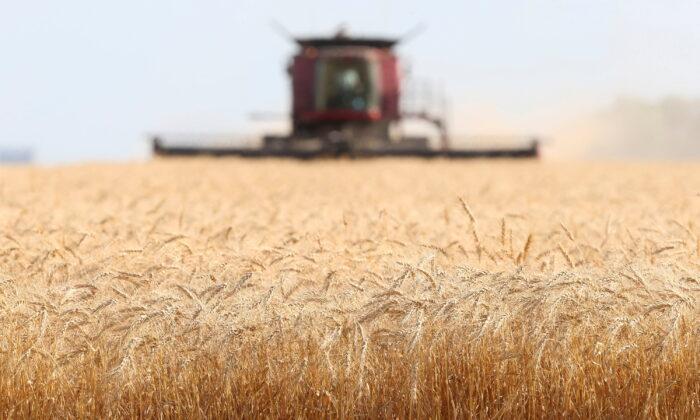WINNIPEG, Manitoba—Russia’s invasion of Ukraine, one of the world’s breadbasket nations, has driven wheat prices to 14-year highs, forcing bread consumers to eat the cost.
Russia’s Feb. 24 invasion has severely hampered trade from Black Sea ports, driving up global Chicago benchmark wheat prices by 40 percent and further pushing global food inflation that was already the highest in a decade.
Supply disruptions from Russia and Ukraine, which together account for 30 percent of world wheat exports and 20 percent of corn exports, will erode food security for millions of people, with the Middle East and north Africa especially vulnerable due to their reliance on imports, said Julie Marshall, spokesperson for the World Food Programme.
Oil and gas prices have also spiked due to sanctions against Russia, while costs of freight and raw materials like steel were already soaring due to pandemic-related supply chain breakdowns.
Even consumers in two of the world’s biggest wheat-growing nations, Canada and the United States, are paying the price.
“Unfortunately for the short and intermediate-term, food inflation and the cost of baked goods in the United States will go up more. This will impact the most vulnerable in our society the most,” said Robb MacKie, president and chief executive of the American Bakers Association.
Weeks before the latest wheat price spike, Calgary Italian Bakery in Alberta raised prices 7 percent to keep pace with costs associated with last year’s Canadian drought and inflation in prices of flour and yeast.
Now Louis Bontorin, co-owner of the 60-year-old family business, fears he will need to raise prices significantly again, once he has depleted his four to five months’ flour supply.
“This could be really, really devastating,” Bontorin said. “Bread is one of the fundamentals, the essentials, and that’s the hard part. You’re trying to just take what you need, but you’re also cognizant of what effect (higher price) has on the consumer.
“The buying power of everybody is just being eroded.”
The threat to wheat supplies from Russia’s invasion of Ukraine has been exacerbated by a drop in global stocks of major exporters.
Supplies in the European Union, Russia, the United States, Canada, Ukraine, Argentina, Australia, and Kazakhstan are set to fall to a nine-year low of 57 million tonnes by the end of the 2021/22 season, International Grains Council (IGC) data shows.

‘Pay the Cost or Don’t Get Your Flour’
Some mills signed contracts with farmers last autumn for the wheat they are currently using, insulating them for now from spikes related to the Russia-Ukraine war.After Russia invaded, Rogers Foods’ President Joe Girdner’s phone started lighting up. The bakers who buy flour from his two British Columbia mills are now looking to secure supplies further out than before, on fears that prices could escalate even more.
It is also a problem for the miller. Spring wheat supplies were already running thin because of drought last year, and now global buyers who were depending on Black Sea supplies, may turn to Canada for wheat and compete with domestic mills, Girdner said.
“It’s a really big concern,” Girdner said of the Russia-Ukraine war. “And the real story will be if this situation drags on.”





